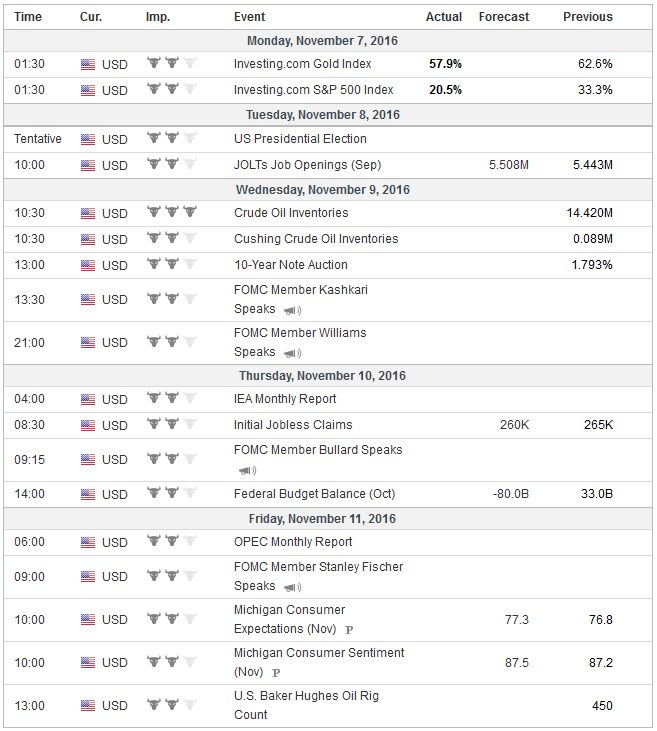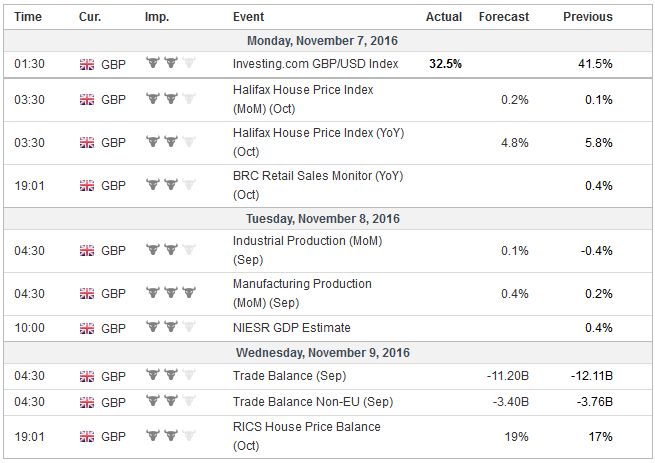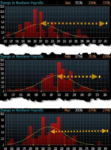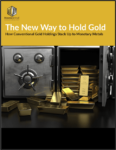Summary:
Neither the Mexican peso’s performance nor the fed funds futures seem to show that investors think the election is very close.
Not all poll analysis showed what the Financial Times called “knife-edge”.
None of the poll analysis showed Trump winning, and many appear to have stabilized over the last couple of days.
The near-term outlook for the capital markets will be driven by the results of the US election on November 8. The narrowing of the polls for the presidential contest reverberated through the markets last week. Equities continued the sell-off that began in two weeks ago. The S&P 500 failed to hold on to early gains before the weekend, and its sell-off extended for nine consecutive sessions, something not seen since Carter was President.
EurozoneEurope’s Dow Jones Stoxx 600 has not posted a gain since October 20. The MSCI Emerging Market equity index has risen in only two sessions since then. Last week, both the German Dax and Japanese Nikkei gapped lower twice, including the last session before the weekend. Bond yields in Europe and the US bottomed in the summer. The increase accelerated in early-October, the tightening of election odds, and the fall in stocks (and oil) helped steady long-term interest rates. |
Economic Events: Eurozone, Week November 07 |
United StatesWe think that there has been some light hedging and position adjustments, but not on the scale of what likely will be seen on a Trump victory. The wide bandwidth for news and its 7/24/365 nature may make it difficult, even for discerning individuals, to see the forest for the trees, and to mix metaphors, distinguish the noise from the signal. As investors and decision-makers, it is often required that we make choices without complete information.This is no different. The outlook for next week, if not longer, will likely be a function of the election outcome. The cynics tell us that both alternatives are poor and untrustworthy. Partisans tell us their candidate is superior. While risk assets were being sold and the security of fixed income was sought, there were two market developments that suggest investors were not so concerned about Trump winning as it may seem at first blush. First, the Mexican peso has been sensitive to the vagaries of the US election campaign. For several weeks, when Trump’s comments saw his standing fall, the Mexican peso staged a strong recovery and was best performing currency last month (2.75%). However, as Trump began doing better, the US dollar rallied 5.75% against the peso (October 25-November 3). The US dollar posted a big outside down day against the peso on November 3. It traded above the previous day’s high. It proceeded to reverse and settled below the previous day’s low. There was following through dollar selling of the peso the following day as well. The peso was the strongest currency before the weekend. It appreciated nearly 0.80%. Despite what may have been interpolated from the equity market slide, if market participants really feared a Trump victory was likely, the peso would have sold-off, or at the very least, under performed. The second important instrument that is telling us investors think a Trump victory is unlikely is the December Fed funds futures strip. The hypothesis is new of a Trump presidency would roil the markets. This market volatility would likely reduce the chances of a Fed hike next month. If one thought that Trump would win, the peso would be lower, and the Fed funds futures would not be so steady. For the last 12 sessions, the December Fed funds futures have been closing between 49.5 bp and 50.5 bp and recall that the bid-spread offer is half a basis point. Bloomberg calculates this to be a 76% chance of a hike, while the CME estimates the odds at 66%. Our own work is in line with Bloomberg’s estimate. Recall the futures contract settles at the average effective Fed funds rate for the month. What will the be that average in December? For the first 14 days, let’s assume Fed funds averages what it has been in recent weeks, 41 bp. Let’s assume the Fed hikes on December 14, and on December 15, Fed funds average the midpoint of the new range (50-75 bp) of 63 bp. However, due to the quarter and year-end, the Fed funds rate will likely fall on Friday, December 30. The Friday rate applies to Saturday, December 31 as well. A reasonable and conservative estimate is that the effective average will slip 15 bp to 48 bp. Add those products together (14*41)+(15*63)+(2*48) and divide by the 31 days of the month, (49.5 bp). The December Fed funds futures contract has discounted 76.5% of 25 bp hike in the target range. |
Economic Events: United States, Week November 07 |
United KingdomPart of the challenge for investors is a misunderstanding about polls in general, and the narrative frequently told around the Scottish and UK referendums. The polls were wrong, we are told, so polls are not helpful. This is not true. In Scotland, most of the polls done for partisan interest found the results they were looking for, but the properly conduct fair polls showed the referendum was going to lose. In the UK, the last dozen polls or so showed a close contest. The markets, including those like myself who saw the murder of the UK MP as a cathartic event that would offset the poorly run campaign of the Remain camp got it wrong. The betting shops got it wrong as some large bets for Remain overwhelmed the most numerous bets favoring Brexit. Ironically, the polls seemed to have gotten it more right than the gamblers and traders. |
Economic Events: United Kingdom, Week November 07 |
Switzerland |
Economic Events: Switzerland, Week November 07 |
There is a divergence in the poll analysis in the US that has become pronounced since the FBI’s announcement on October 27 about the new development about Clinton’s emails. Some, including Fivethirtyeight.com, and RealClearPolitics see the race as having tightened considerably. The former has Clinton as favored 65.5% chance of winning, after peaking near 88% a couple of days before the third debate. The latter has Clinton ahead by 1.8 percentage points in a survey of national polls. The Financial Times caught this spirit in the headline of its weekend edition: “US election knife-edge as rivals weigh early-voting data.”
Their calculations of how the electoral college may breakdown, both put Trump less than 30 electoral college votes shy. That means that one large state, like Florida (which fivethirtyeight.com has leaned toward Trump and RealClearPolitics have favoring Clinton by 1.2 percentage points) can give deliver Trump a victory.
There is another set of respected poll work that sees it quite differently. These include the New York Times Upshot, Huffington Pollster,Princeton Election Consortium. They, like the peso and Fed funds futures, have been unflappable. Upshot puts the odds at 84% Clinton wins. She peaked at 93%. Huffington puts it at 98.4, and Princeton puts the odds at 99%.
Despite the divergence of the analysis, none show Trump as the favorite, and most show some stabilization in the last couple of days, We are inclined to see the recent market moves as a fundamentally-spurred technical correction. We suspect that that correction is over or nearly so. When the US political uncertainty is lifted, the economic divergence can reassert itself as the main driver. Although the job growth reported before the weekend was nothing to get excited about, the uptick in hourly earnings growth to its fastest pace since 2009 (2.8%) is a wholly desirable development. It makes it easier for the Fed to remove some accommodation, but a 25 bp rate hike to 50-75 bp is hardly a tightening of policy.
All bets are off if Trump wins. This is not said out of partisanship, but a function of induction (how investors have responded to such prospects) and deduction (investors don’t like the unknown or surprises. A Trump victory is both on steroids). Given the seemingly limited path Trump has to the White House, two states on the East Coast, Florida, and North Carolina will likely be indicative of the election outcome. Trump must win both or defeat is all but certain. These may be known in the Asian morning on November 9. Trump must go on to win nearly every other swing state, including Pennsylvania.
We understand that Clinton would become President under a cloud given the FBI’s recent announcement and the high unfavorable ratings. If the Democrats fail to secure a Senate majority, Clinton will have an even more difficult time of things. On the other hand, Obama’s moderate nomination for the Supreme Court may be more appealing to the lame duck session than a potential Clinton nominee. The same is true of the two vacancies on the Board of Governors of the Federal Reserve. At the same time, the Republican-dominated Congress will loath to make any last minute concessions to Obama, having fought tooth and nail for nearly then entire two-terms, and this includes at Trans-Pacific Partnership trade agreement.
As a Senator and Secretary of State, Clinton was able to work across the aisle with Republicans. A Democrat Senate, and ambitions of the Republican leadership in the House (assuming that does not change) may boost bipartisan opportunities. A Democrat sweep of both chambers is not particularly likely. In such a scenario, though the key driver may be bonds, which we suspect investors would sell in a bearish steepening. In the current environment, it likely would be dollar-friendly.
Full story here Are you the author? Previous post See more for Next post
Tags: #USD,Federal Reserve,MXN,newslettersent






































